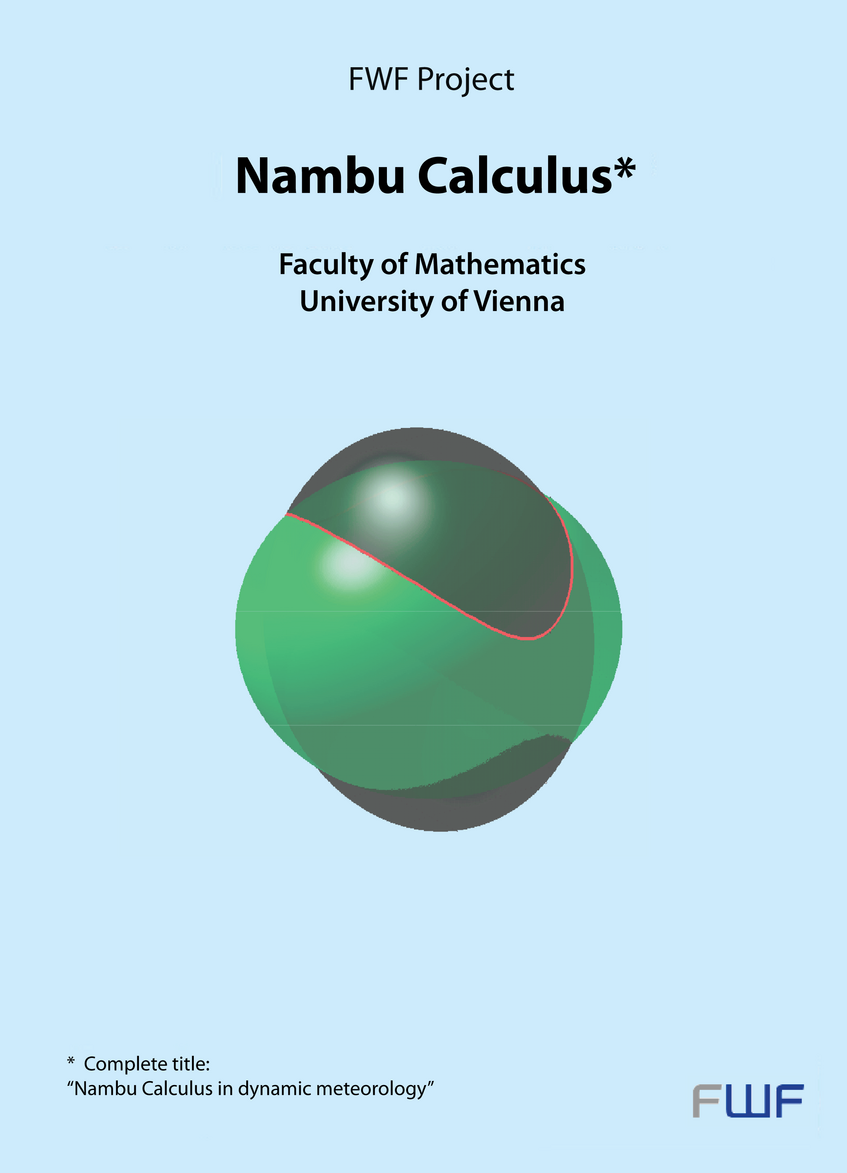Nambu Calculus in Dynamical Meteorology

© Universität Wien
Nambu Calculus in Dynamical Meteorology
Members:
- emer. o. Univ.-Prof. Dr. Michael Hantel (principal investigator)
- Mag.Dr. Alexander Bihlo
- Mag.Dr. Katharina Brazda
- Dr. Matthias Sommer
- Prof. Dr. Roman Popovych (Faculty of Mathematics)
Project description:
Nambu calculus is a formalism designed for convenient representation of a number of classical mechanical systems. It has originally been developed by Nambu (1973) for the dynamics of discrete mass points; somewhat later, authors applied it to the continuous field equations of dynamical meteorology. These attempts have been promising, specifically in form of the energy-vorticity-theory as developed recently by Névir (1998). The present proposal aims at further developing this new approach through both generalizing its formal foundations and applying it to an extended class of relevant fluid dynamic problems. Goal of this proposal is to show that the new theory, by using the Nambu calculus together with the methods of differential geometry, including Lie group theory, has the potential to unify the principles of dynamic meteorology. One important step will be to examine how the discrete Nambu structures are related to the continuous partial differential equations of fluids.
The project will in its theoretical part focus upon the inviscid barotropic vorticity equation, the prototype of nonlinear geophysical fluid dynamics. It possesses, in the framework of energy-vorticity dynamics, a characteristic form, the trilinear Nambu bracket, that reveals the geometric structure of the continuous vorticity equation. An equivalent formalism is applicable to higher-order problems like Rayleigh-Bénard convection which has two unknown functions and includes dissipation; the latter generalization leads to Nambu-metriplectic systems.
The project will in its applied part focus upon exploring the potential of the energy-vorticity theory for running discrete, but structure-preserving, low-order models of fluid dynamics. This task will be done by supplementing the traditional Galerkin methods with the information contained in the Nambu form of the corresponding continuous equations.
Presentations:
- 2012/10/01-05: Vorträge beim Theoretiker-Treffen `Geometric Methods in Theoretical Meteorology´, Wien
- 2010/10/07: K. Brazda, M. Sommer, `Lie-Poisson-Klammern in der Fluiddynamik´, Arbeitskreis Theoretische Meteorologie, Kloster Schöntal, Germany
- 2009/11/06: A. Bihlo, K. Brazda, M. Hantel, `Der Nambu-Kalkül in der dynamischen Meteorologie´, 3. Österreichischer MeteorologInnentag, Graz, Austria
- 2009/04/23: A. Bihlo, R.O. Popovych, `Symmetry methods in dynamic meteorology´, European Geosciences Union – General Assembly, in session AS1.13 Recent developments in geophysical fluid dynamics, Vienna, Austria
- 2008/07/27-30: A. Bihlo, `Symmetry methods in dynamic meteorology´, Applications of Computer Algebra (ACA2008), in session Symbolic Symmetry Analysis and Its Applications, RISC, Castle of Hagenberg, Austria
- 2008/04/17: A. Bihlo, `Application of finite and infinite dimensional Nambu mechanics in dynamic meteorology´ European Geosciences Union – General Assembly, in session AS1.11 Recent developments in geophysical fluid dynamics, Vienna, Austria
Publications:
- M. Sommer, K. Brazda, and M. Hantel, 2012: `Statistical mechanics for conservative discretizations of two-dimensional incompressible flow´, Meteorologische Zeitschrift 21 (4), 371-384.
- A. Bihlo, E. Dos Santos Cardoso-Bihlo and R.O. Popovych, 2012: `Complete group classification of a class of nonlinear wave equations´, J. Math. Phys. 53, 123515. arXiv:1106.4801
- M. Sommer, K. Brazda, and M. Hantel, 2011: `Algebraic construction of a Nambu bracket for the two-dimensional vorticity equation´, Phys. Lett. A 375 (37), 3310-3313. arXiv:1102.1298
- A. Bihlo and J. Staufer, 2011: `Minimal atmospheric finite-mode models preserving symmetry and generalized Hamiltonian structures´, Physica D 240 (7), 599-606. arXiv:0909.1957
- M. Sommer and S. Reich 2010: `Phase Space Volume Conservation under Space and Time Discretization Schemes for the Shallow-Water Equations´, Mon. Wea. Rev. 138, 4229–4236.
- A. Bihlo and R.O. Popovych, 2010: `Symmetry justification of Lorenz’ maximum simplification´, Nonlinear Dyn 61, 101–107. arXiv:0805.4061
- A. Bihlo and R.O. Popovych, 2009: `Lie symmetries and exact solutions of barotropic vorticity equation´, J. Math. Phys. 50, 123102 (12pp). arXiv:0902.4099
- A. Bihlo and R.O. Popovych, 2009: `Symmetry Analysis of Barotropic Potential Vorticity Equation´, Comm. Theor. Phys. 52, 697–700. arXiv:0811.3008
- A. Bihlo, 2009: `Symmetries in atmospheric sciences´, In Proceedings of the Fourth International Workshop “Group Analysis of Differential Equations & Integrable Systems” (26-30 October 2008, Protaras, Cyprus), 6–12. arXiv:0902.4112
- A. Bihlo, 2008: `Rayleigh-Bénard Convection as a Nambu-metriplectic problem´, J. Phys. A: Math. Theor. 41, 292001 (6pp). arXiv:0803.4458
